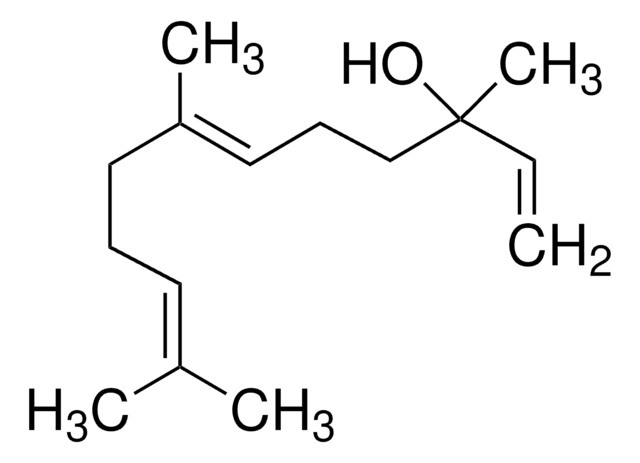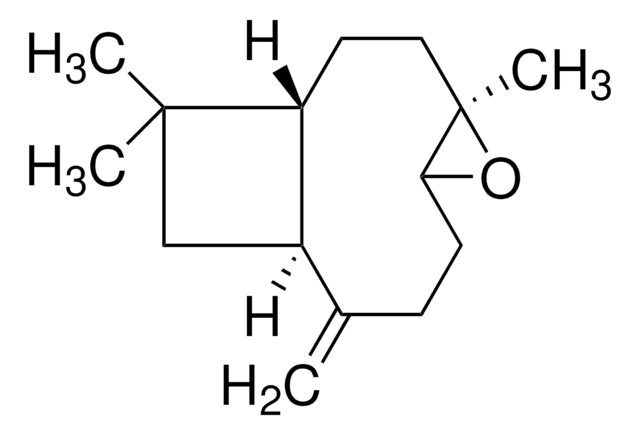Kluczowe dokumenty
W247804
Farnesol
mixture of isomers, ≥95%, stabilized, FG
Synonim(y):
3,7,11-Trimethyl-2,6,10-dodecatrien-1-ol
About This Item
Polecane produkty
pochodzenie biologiczne
synthetic
Poziom jakości
klasa czystości
FG
Halal
Kosher
zgodność regionalna
EU Regulation 1334/2008 & 178/2002
FDA 21 CFR 117
FDA 21 CFR 172.515
Próba
≥95%
zawiera
α-tocopherol (synthetic stabilizer)
może zawierać
≤50 ppm hexane
współczynnik refrakcji
n20/D 1.489 (lit.)
bp
149 °C/4 mmHg (lit.)
gęstość
0.886 g/mL at 20 °C (lit.)
Zastosowanie
flavors and fragrances
Dokumentacja
see Safety & Documentation for available documents
alergen pokarmowy
no known allergens
Organoleptyczne
fresh; floral; sweet
ciąg SMILES
C/C(CC/C=C(C)/CCC=C(C)C)=C\CO
InChI
1S/C15H26O/c1-13(2)7-5-8-14(3)9-6-10-15(4)11-12-16/h7,9,11,16H,5-6,8,10,12H2,1-4H3/b14-9+,15-11+
Klucz InChI
CRDAMVZIKSXKFV-YFVJMOTDSA-N
Szukasz podobnych produktów? Odwiedź Przewodnik dotyczący porównywania produktów
Powiązane kategorie
Zastosowanie
- Farnesol repurposing for prevention and treatment of Acinetobacter baumannii biofilms.: This article explores the efficacy of repurposing farnesol for preventing and treating biofilms caused by Acinetobacter baumannii, highlighting its potential as an antibacterial agent (Tan et al., 2024).
- Methyl-Jasmonate Functions as a Molecular Switch Promoting Cross-Talk between Pathways for the Biosynthesis of Isoprenoid Backbones Used to Modify Proteins in Plants.: This study investigates the role of methyl-jasmonate in regulating the biosynthesis of isoprenoid backbones, which are crucial for post-translational modification of proteins in plants and may involve farnesol as an intermediate or by-product (Chevalier et al., 2024).
- Repurposing Farnesol for Combating Drug-Resistant and Persistent Single and Polymicrobial Biofilms.: This article discusses the potential of repurposing farnesol to combat drug-resistant and persistent biofilms, demonstrating its utility in enhancing antibiotic efficacy and addressing antimicrobial resistance (Tan et al., 2024).
Działania biochem./fizjol.
Inne uwagi
Hasło ostrzegawcze
Warning
Zwroty wskazujące rodzaj zagrożenia
Zwroty wskazujące środki ostrożności
Klasyfikacja zagrożeń
Aquatic Acute 1 - Aquatic Chronic 1 - Skin Irrit. 2 - Skin Sens. 1
Kod klasy składowania
10 - Combustible liquids
Klasa zagrożenia wodnego (WGK)
WGK 2
Temperatura zapłonu (°F)
311.0 °F - closed cup
Temperatura zapłonu (°C)
155 °C - closed cup
Środki ochrony indywidualnej
Eyeshields, Gloves, multi-purpose combination respirator cartridge (US)
Wybierz jedną z najnowszych wersji:
Masz już ten produkt?
Dokumenty związane z niedawno zakupionymi produktami zostały zamieszczone w Bibliotece dokumentów.
Klienci oglądali również te produkty
Global Trade Item Number
| SKU | GTIN |
|---|---|
| W247804-100G | |
| W247804-1KG | |
| W247804-250G | |
| W247804-250G-K | |
| W247804-100G-K | 4061837515101 |
| W247804-1KG-K | 4061837800207 |
| W247804-SAMPLE | |
| W247804-SAMPLE-K | 4061837515118 |
Nasz zespół naukowców ma doświadczenie we wszystkich obszarach badań, w tym w naukach przyrodniczych, materiałoznawstwie, syntezie chemicznej, chromatografii, analityce i wielu innych dziedzinach.
Skontaktuj się z zespołem ds. pomocy technicznej








